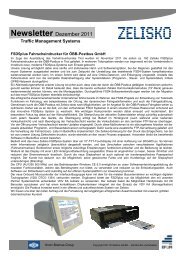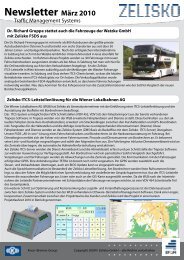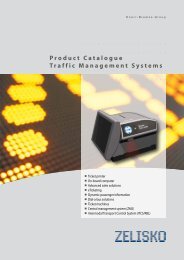Annual Report 2012 - Knorr-Bremse AG.
Annual Report 2012 - Knorr-Bremse AG.
Annual Report 2012 - Knorr-Bremse AG.
You also want an ePaper? Increase the reach of your titles
YUMPU automatically turns print PDFs into web optimized ePapers that Google loves.
20<br />
Overall assessment of the economic<br />
position of the Group<br />
economic efficiency were defined and launched in the<br />
year under review.<br />
The consolidated balance sheet total rose 3.3% in <strong>2012</strong><br />
to EUR 2,615.0 million (2011: EUR 2,530.4 million), largely<br />
influenced by the rise in liquid funds. At year-end <strong>2012</strong>,<br />
total assets represented 60.8% of sales. As a proportion of<br />
the balance sheet total, intangibles, fixed assets, and investments<br />
were down from 32.7% in the prior year to<br />
31.7%. Working capital, defined as the sum of inventories<br />
and accounts receivable, minus accounts payable trade,<br />
stood at EUR 463.0 million at year-end (2011: EUR 470.6<br />
million) or 39 days’ sales (2011: 40 days). The equity ratio<br />
rose by 2.4 percentage points from 35.7% to 38.1%.<br />
Of the Group’s total assets, 49.9% are tied up in the European<br />
region, 22.5% in the Americas, and 27.6% in the<br />
Asia/Australia region. The increase in net liquidity to EUR<br />
551.0 million was achieved primarily by an inflow of<br />
funds from gross cash flow in the amount of EUR 515.4<br />
million. Substantial capital requirements were generated<br />
in <strong>2012</strong> by capital expenditure (EUR 165.8 million) and<br />
dividends (EUR 184.9 million). The ratio of net liquidity to<br />
shareholders’ equity stood at 55.4%, compared to 44.0%<br />
in 2011.<br />
<strong>Knorr</strong>-<strong>Bremse</strong>’s robust strategic positioning, the positive<br />
development of the company’s business and its excellent<br />
working capital management were confirmed by<br />
the external rating agencies Standard & Poor’s and<br />
Moody’s, who have been rating the <strong>Knorr</strong>-<strong>Bremse</strong> Group<br />
since 2000. Both Moody’s and Standard & Poor’s confirmed<br />
their prior-year ratings of “A3/Outlook stable” and<br />
“A-/Outlook stable” respectively. This means that <strong>Knorr</strong>-<br />
<strong>Bremse</strong> remains the only family-owned company in the<br />
Standard & Poor’s Global Automotive Suppliers Ranking<br />
<strong>2012</strong> to be awarded an “A” rating.<br />
Within the general economic environment described<br />
above, the <strong>Knorr</strong>-<strong>Bremse</strong> Group maintained its overall position<br />
with regard to its assets and financial status, and<br />
was able to further improve its liquidity position. The<br />
Group’s profitability was ensured by rigorous cost management<br />
and above all by the internal optimization of<br />
processes and structures.<br />
With an equity ratio of 38.1% and net liquidity of EUR<br />
551.0 million, the structure of the Group’s assets is extremely<br />
stable.<br />
<strong>Knorr</strong>-<strong>Bremse</strong> <strong>AG</strong><br />
As the parent company, <strong>Knorr</strong>-<strong>Bremse</strong> <strong>AG</strong> performs the<br />
role of service provider and holding company, as well as a<br />
strategic management function on the operational side.<br />
Falling income from investments in associated and related<br />
companies, resulting from reduced transfer of profits<br />
from the Rail Vehicle Systems division, meant that income<br />
before taxation decreased to EUR 134.9 million in the year<br />
under review (2011: EUR 183.2 million).<br />
Along with interests in affiliated companies, the balance<br />
sheet of <strong>Knorr</strong>-<strong>Bremse</strong> <strong>AG</strong> largely reflects receivables from<br />
and payables to Group companies and these are centrally<br />
administered, partly within the framework of a cash-pooling<br />
process managed by <strong>Knorr</strong>-<strong>Bremse</strong> <strong>AG</strong>. <strong>Knorr</strong>-<strong>Bremse</strong><br />
<strong>AG</strong> acts as an in-house bank for its subsidiaries around the<br />
world. This includes handling the central hedging of market<br />
price risks. The subsidiaries contract their hedging<br />
transactions with <strong>Knorr</strong>-<strong>Bremse</strong> <strong>AG</strong>, which in turn hedges<br />
part or all of the net residual risk for the Group with external<br />
banks.<br />
With the aid of the global process standardization and<br />
transparency achieved through <strong>Knorr</strong> Excellence, <strong>Knorr</strong>-<br />
<strong>Bremse</strong> <strong>AG</strong> is able to efficiently control its own business<br />
and that of the associated and related companies.



![1 Newsletter 2013 Version 0 92 [Kompatibilitätsmodus] - Zelisko](https://img.yumpu.com/50939577/1/184x260/1-newsletter-2013-version-0-92-kompatibilitaatsmodus-zelisko.jpg?quality=85)




![Backofficelösung ZMS [PDF, 740 kB] - Zelisko](https://img.yumpu.com/33964695/1/184x260/backofficelaasung-zms-pdf-740-kb-zelisko.jpg?quality=85)

![Geschäftsbericht 2012 [PDF, 13 MB] - Zelisko](https://img.yumpu.com/31517535/1/184x260/geschaaftsbericht-2012-pdf-13-mb-zelisko.jpg?quality=85)


![Produktkatalog Gesamtlösungen [PDF, 4 MB] - Zelisko](https://img.yumpu.com/22973479/1/182x260/produktkatalog-gesamtlaasungen-pdf-4-mb-zelisko.jpg?quality=85)
![ITCS Datenblatt [PDF, 804 kB] - Zelisko](https://img.yumpu.com/22855155/1/184x260/itcs-datenblatt-pdf-804-kb-zelisko.jpg?quality=85)
![Fahrscheindrucker FSD5plus [PDF, 934 kB] - Zelisko](https://img.yumpu.com/22822643/1/184x260/fahrscheindrucker-fsd5plus-pdf-934-kb-zelisko.jpg?quality=85)
